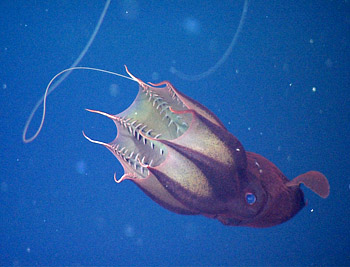As the only extant member of its Family, Vampyroteuthis infernalis, or the vampire squid, possesses some very unique features that phylogenetically distinguish it from other members of its class, Cephalopoda. Despite its name, the vampire squid is not a squid in the slightest; rather, it is distinct from squid and octopuses in its physiology, behavior, and trophic ecology. V. infernalis resides in the deep sea, approximately 600-3300 meters below the surface, in the meso- and bathypelagic zones. Throughout the deep sea, hypoxic and anoxic areas known as oxygen minimum zones (OMZs) are fairly common; these zones are much harder for organisms to occupy due to low oxygen concentrations. However, life in the deep sea has evolved and adapted to withstand such conditions. For example, the vampire squid has the ability to suppress its aerobic metabolic rate to survive and feed in OMZs.
Two retractile filaments—a feature other cephalopods lack—allow V. infernalis to feed on planktonic organisms and detritus. These specialized sensory and feeding appendages can extend to twice its body length, allowing it to collect and consume particulate organic matter (POM), or marine snow. Many cephalopods are predatory, typically eating various crustaceans, small fish, or other mollusks; however, the vampire squid is a detritivore, and therefore passively feeds on the organic matter that sinks from the surface. Passive feeding prevents energy expenditure in the low-oxygen environment where this organism resides. This feeding method allows this organism to access nutrients in areas that other organisms may have a more difficult time utilizing.
Not only is the vampire squid trophically and behaviorally unique, but it also has the largest eye size-to-body ratio of any extant or extinct animal. Considering this species lives in the aphotic deep sea, where no sunlight penetrates, this eye-to-body ratio gives V. infernalis an ocular advantage; therefore, it has a heightened sensitivity to bioluminescence and ability to navigate the deep ocean. Physiologically, its blood contains a respiratory protein known as hemocyanin, which has a high affinity for oxygen, ultimately allowing it to absorb O2 in the most efficient way possible in OMZs. The vampire squid is a complex and poorly studied species that displays a vast array of distinct characteristics that make it an important aspect in deep-sea studies.
